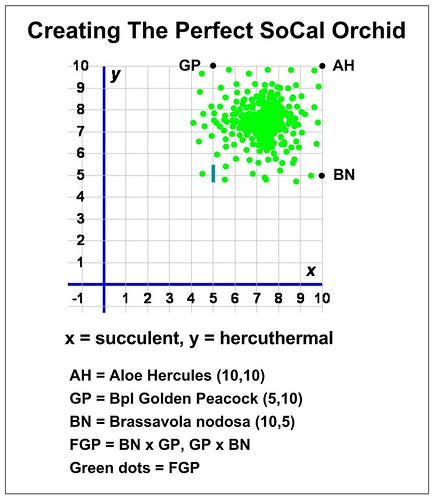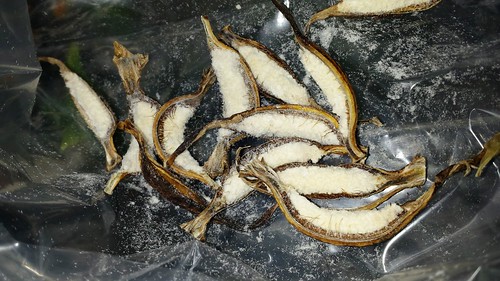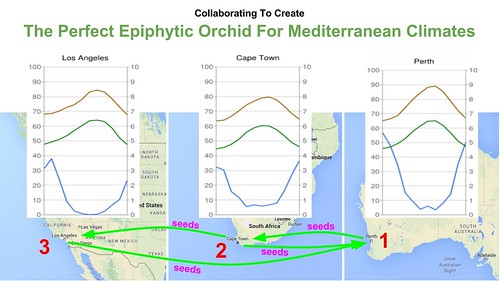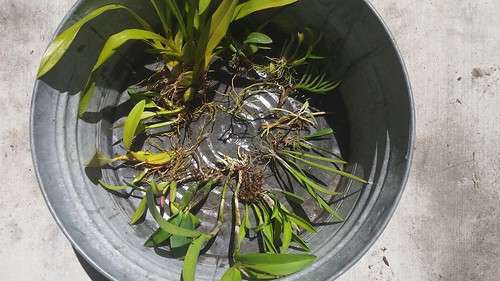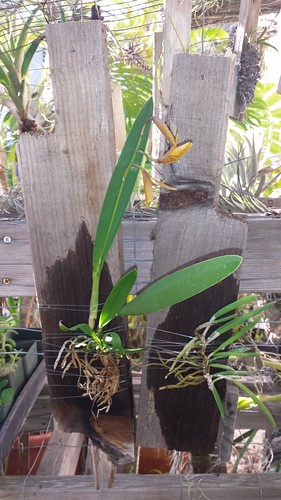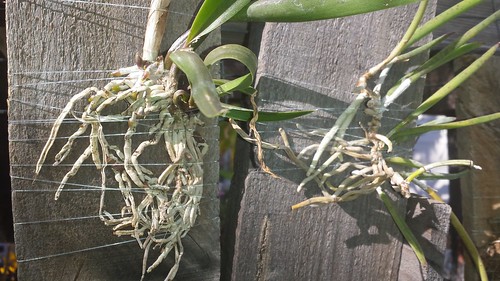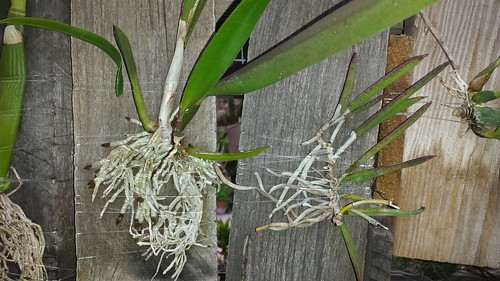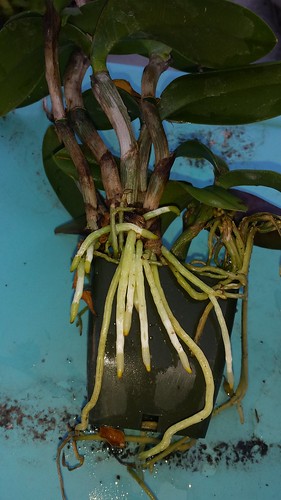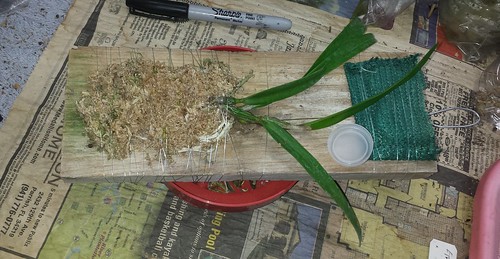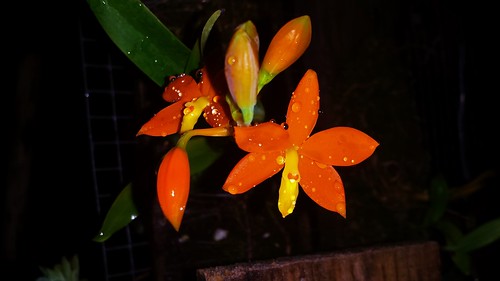*******************************************
The problem, as I see it, is that the ability to hold and carry multiple objects isn't limited to humans. - Quokkastan
But I've never argued that humans are the only animals with linvoid1. I've argued that humans are the most linvoid1.
And humans aren't even necessarily the best at it. - Quokkastan
What animals are more linvoid1 than humans?
You've side-stepped the issue by saying that the mental faculties required to see value in multiple items, in holding on to them, and in combining them in creative ways, also counts. But that essentially is human intelligence. An enormous part of it in any case.
So what you're ultimately arguing is that human intelligence created human intelligence. - Quokkastan
I'm arguing that our exceptional intelligence is the result of linvoid3... which is the result of linvoid1.
Take a look at this photo...
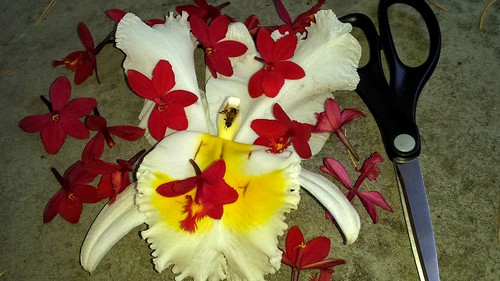
The large white flower is from a Cattleya orchid that is growing on my tree. A honey bee visited the flower and died as a result. The Cattleya didn't intentionally kill the bee. There aren't any carnivorous orchids. The bee entered the flower and got stuck to the orchid's built in "glue". The bee wasn't able to free itself and died. If the bee had been able to free itself... then it would have continued deeper into the flower where it would have been rewarded with some nectar... or been tricked? Some orchids are notoriously deceptive. In any case, the bee would have turned around and, just as it was about to exit, the flower would have deposited its pollen onto the bee's gluey back. When the bee entered into the next orchid flower... the pollen on its back would have gotten stuck exactly where the bee had gotten stuck to.
The bee essentially died during sex. Well... it died while it was attempting to facilitate orchid sex. The same thing could have been said for me if I had fallen out of the tree while attempting to pollinate the Cattleya.
Neither the orchid nor the bee are native to California or to the US. The orchid is a hybrid but its ancestors are all native to the Americas. The bee isn't even native to the Americas.
Maybe you find this story fascinating but you're wondering what it has to do with the evolution of human intelligence. Well... the bee died because it wasn't strong enough to extricate itself from the flower's sticky part. This is an example of selection pressure. In this case... we're not talking about linvoid2 (selecting for intelligence)... we're talking about selecting for strength. The bee was killed because it was too weak. It wasn't strong enough to survive the orchid's "gauntlet".
Right now California doesn't have very many people who grow Cattleya orchids outdoors. This means that the pressure that Cattleyas exert on California bees is vanishingly small. It's imperceptible. But we can imagine that... if more and more people in California started growing Cattleyas... the selection pressure would grow more and more perceptible. More and more bees would be killed by Cattleyas. If everybody in California had Cattleyas blooming on their trees... would this kill all the bees in California? Probably... not.
It's a given that no two bees are equally strong. Why is it a given? Because "difference" is the very point of sexual reproduction. "Difference" allows species to hedge their bets. "Difference" helps species adjust to constantly changing conditions/circumstances. More and more people growing Cattleyas is an example of changing conditions. As more and more weaker bees are killed off... more and more exceptionally strong bees would survive to pass on their genetic material... and the population of bees in California would shift accordingly.
It might help to read this passage...
Sex responds instead to a different mandate, which I will call the mandate of genetic diversity. Evolution requires imperfect reproduction. In simple organisms with extremely large populations, such as bacteria, genetic mutation supplies the necessary imperfection. In species with more limited populations, including most multicellular organisms, mutation does not occur rapidly enough to permit evolution to operate at high enough speeds to allow species to adapt effectively to changing environmental conditions (in particular, to quickly evolving viruses, bacteria, and other parasites). Here sex - the production of offspring through the mixing of genetic material - comes to the rescue. Populations of creatures that reproduce sexually will be far more genetically diverse than populations of similar size that reproduce without such genetic mixing. When environmental conditions change, it is more likely that some portion of the sexually reproducing population will already carry the genes necessary to deal with that change. In other words, sex allows us to evolve to meet changing conditions more quickly.
If genetic diversity is adaptive, we ought to observe the mandate of genetic diversity operating in our choice of mates. And we do. Despite sex, we could reproduce more perfectly, and thereby respond more effectively to the mandate of reproduction, by mating with our closest genetic kin - in other words, through incest. The mandate of genetic diversity, however, predicts the evolution of inhibitions to incest; and, indeed, we all carry such inhibitions, both genetic and learned. The mandate of genetic diversity also predicts that our mating choices will be somewhat random; and, indeed, we often fall in love with unexpected, sometimes even objectively unsuitable, partners. As Pascal observed: "Le coeur a ses raisons, que la raison ne connait point." ("The heart has its reasons, of which reason knows not.") - Theodore P. Seto, Reframing Evil in Evolutionary and Game Theoretic Terms
If, in the future, California has exceptionally strong bees, then the cause would be the exceptional selection pressure that millions of Cattleyas put on the bees. Are humans exceptionally strong? Nope. But we are exceptionally intelligent. The cause of our exceptional intelligence was linvoid3 (exceptionally large amounts of linvoid2 (selection pressure on intelligence)).
In the example of the Cattleyas and the bees... the bees changed because their circumstances/conditions changed (more and more Cattleyas were grown in California). But with our early ancestors... linvoid3 wasn't the result of changing conditions... it was the result of our ancestors themselves changing. They became more and more bipedal.
With all of this in mind... let's take another look at your argument...
You've side-stepped the issue by saying that the mental faculties required to see value in multiple items, in holding on to them, and in combining them in creative ways, also counts. But that essentially is human intelligence. An enormous part of it in any case.
So what you're ultimately arguing is that human intelligence created human intelligence. - Quokkastan
We both agree that our ancestors became more and more bipedal. We also both agree that this helped them to become more linvoid1. Becoming bipedal freed up their hands and arms to simultaneously carry different resources (linvoid1). You're under the impression that I'm arguing that our ancestors became more intelligent because they were more intelligent. But, as you pointed out, this would be a circular reasoning.
What I'm actually arguing is that linvoid1 caused linvoid3. Walking upright forced our ancestors to confront complex carrying choices. How many different things would they have wanted to carry with them when they migrated? Here are some pretty basic things...
- children
- food
- tools
- weapons
Being able to simultaneously carry more than one thing made this problem very complex. It wasn't a relatively simple problem of children OR food OR tools OR weapons... it was a complex problem of children AND/OR food AND/OR tools AND/OR weapons.
The complexity of this problem resulted in linvoid3. Whenever anybody went anywhere... they were confronted with a complex math problem. Individuals that were exceptionally good at solving these complex math problems were more likely to survive and shift the population in the direction of more intelligence.
The complex math problem is, more specifically, a complex economic problem. The problem is how to allocate resources in order to maximize benefit.
All organisms are confronted with the problem of how to allocate resources... even plants. The Cattleya on my tree has to decide how to allocate its limited resources between growing and blooming (reproducing). Insects can allocate more resources than plants can. This means that insects are confronted with more complex economic problems than plants. Mammals can allocate more resources than insects can... which means that mammals are confronted with more complex economic problems than insects. Out of all the mammals... humans can allocate the most resources... which means that humans are confronted with the most complex economic problems.
The more complex the economic problems.... the more intelligence required to solve them. Humans are the most intelligent animals... which reflects the fact that humans solve the most complex economic problems. Our ability to solve the most complex problems reflects the fact that we can allocate the most resources. And what, exactly, allows us to allocate the most resources? Linvoid1.
In theory we could select for raccoons that are more and more bipedal. Doing so would make them more linvoid1... which would result in linvoid3 and voila! Raccoons would be just as intelligent as we are. The first thing you saw when Seldon resurrected you would be a raccoon checking your vitals.
